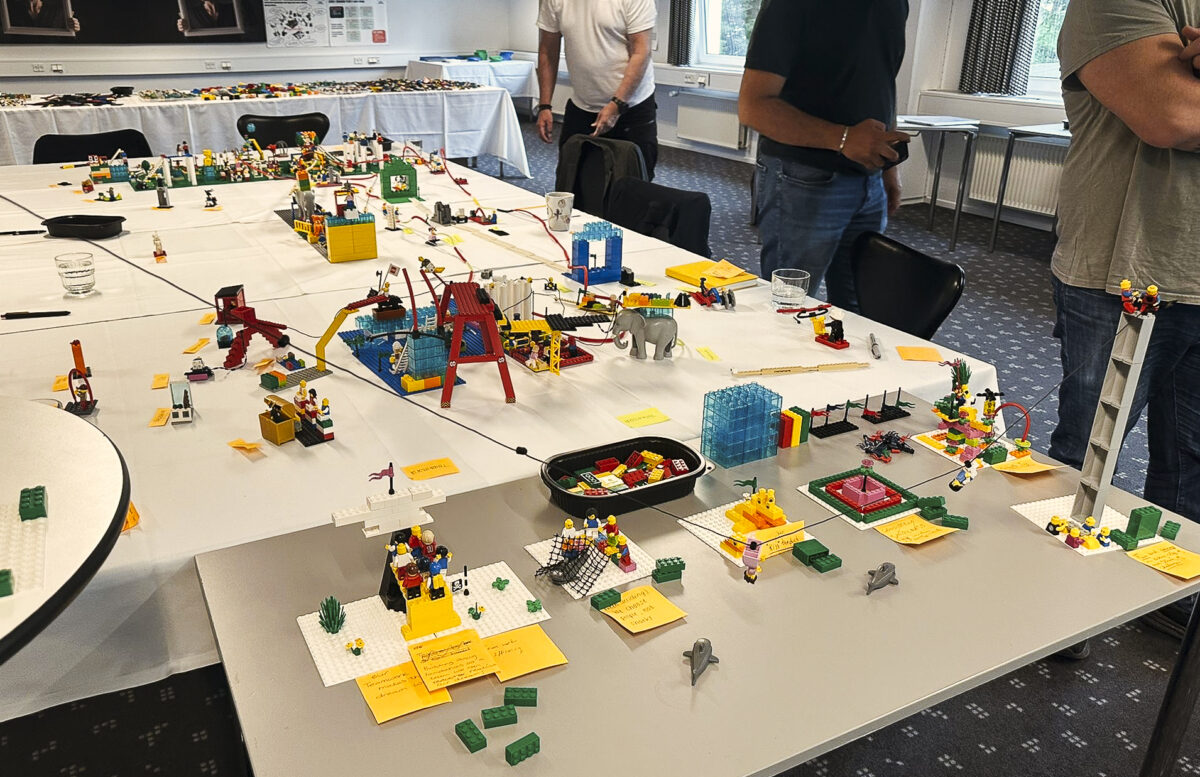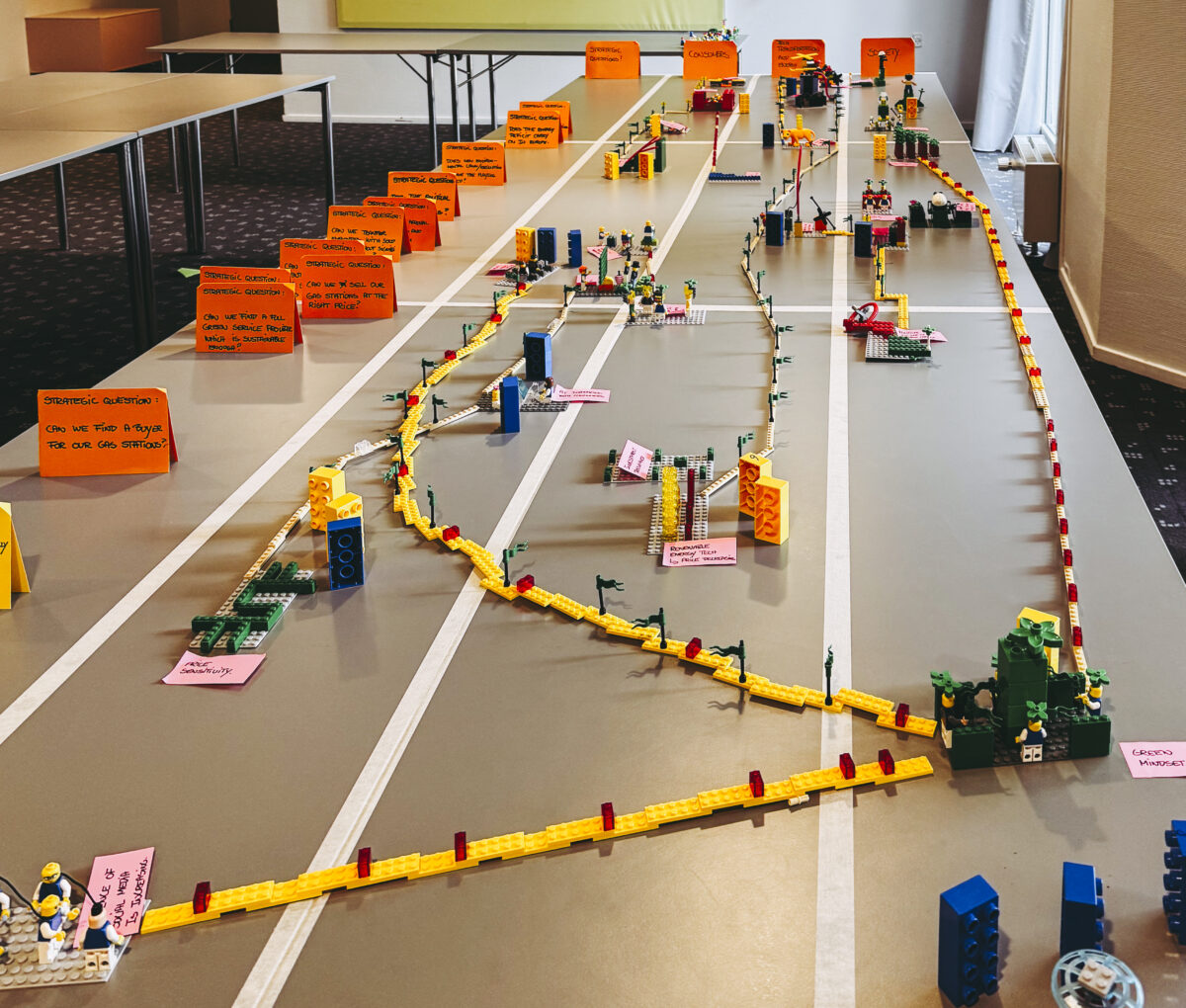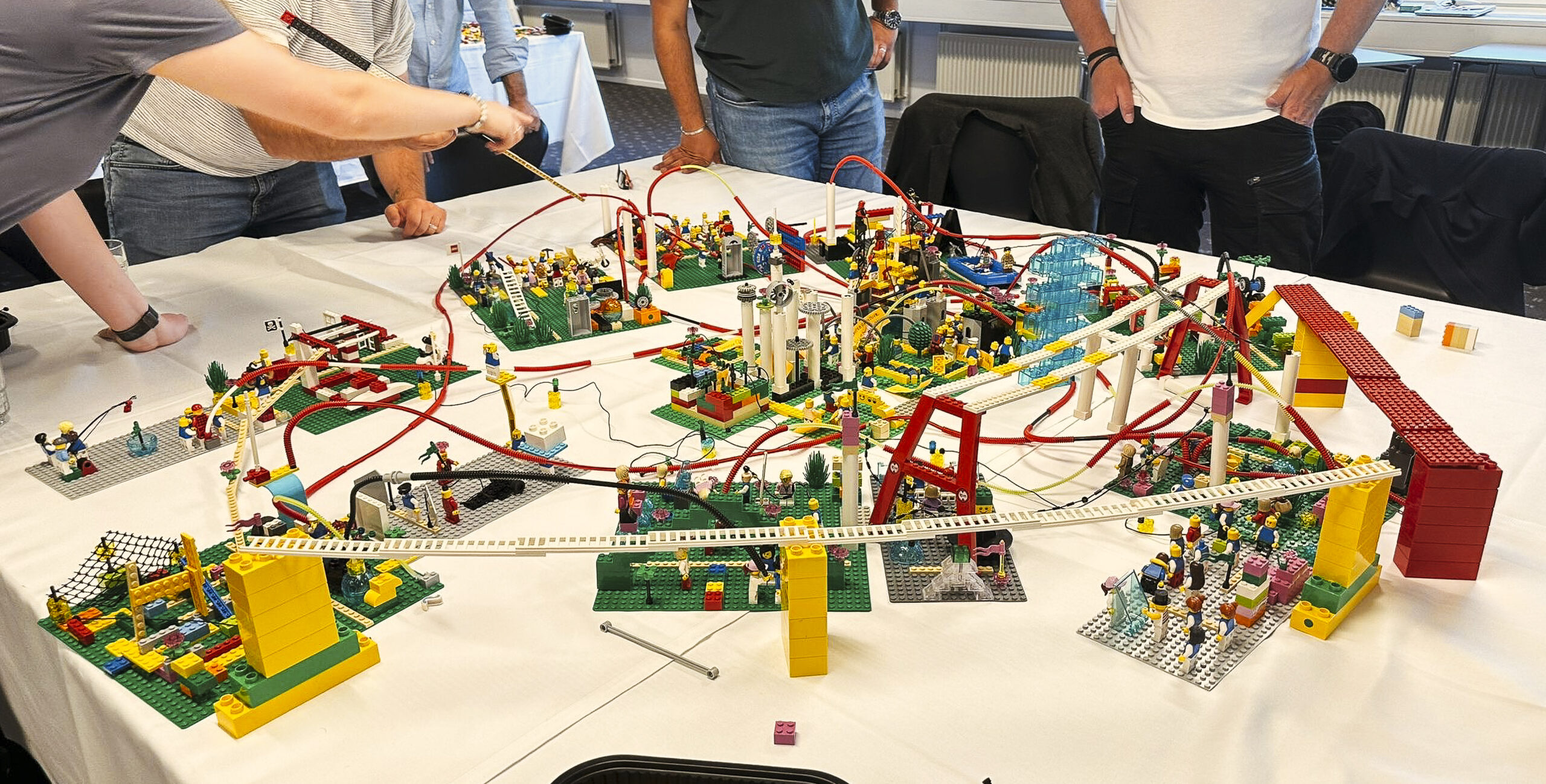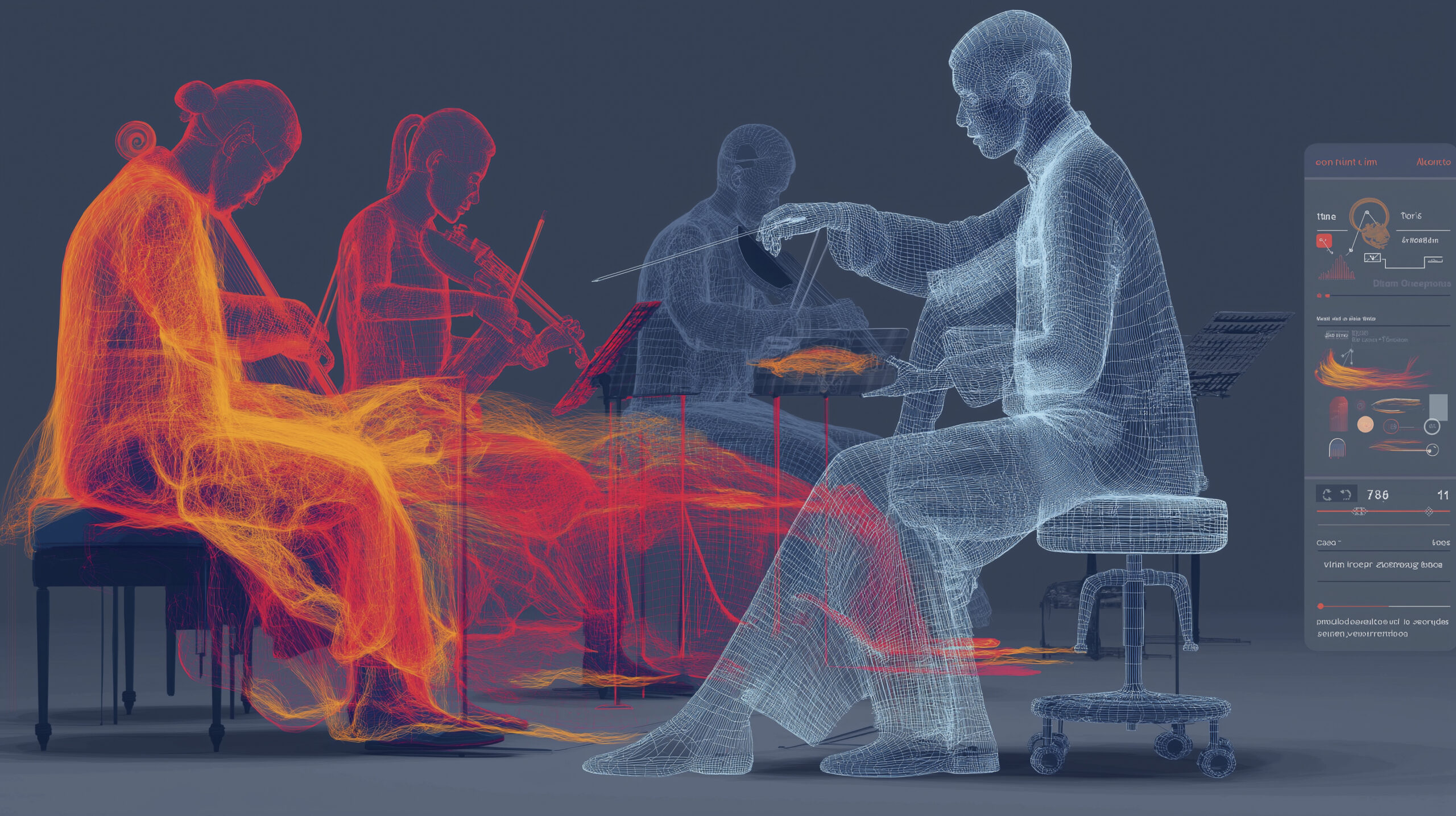Unlocking Business Success with LEGO® SeriousPlay®: From Clarity to Strategic Alignment
Picture a group of diverse professionals from different industries gathered around a white table, not leaning over spreadsheets or slides, but leaning over piles of LEGO® bricks. I was among them recently, immersed in an intense journey of structured creativity, dynamic facilitation, and storytelling through bricks, learning how to lead workshops that are not only engaging and informative but psychologically safe.
After completing my enhanced complete certification in the LEGO® SeriousPlay® (LSP) methodology via Inthrface (yes, at Hotel LEGOLAND in Denmark – where else?), I emerged with more than just a certification. I returned equipped with a powerful new tool in my toolkit; one that transforms abstract business problems into tangible models and compelling narratives. LEGO® SeriousPlay® is more than “just play”; it’s a proven method that gives every voice a visible shape and every challenge a physical model to explore, turning ideas into impactful solutions that improve the present and positively influence the future.
What is LEGO® SeriousPlay® and Why Works: A Brick-Based Breakthrough
At its core, LEGO® SeriousPlay® methodology is a facilitated process using LEGO® bricks for enhanced communication, problem-solving, and creative thinking. Participants build 3D models to represent their ideas and share these visual stories, turning abstract concepts into tangible objects. Complex strategies become castles, customer segments turn into mini-figures, and obstacles appear as brick walls.
By literally “thinking with our hands,” LSP activates multiple areas of the brain, unveiling insights typically hidden in conventional meetings. Importantly, this method promotes active equal participation, giving quieter team members a powerful platform for expression. This psychologically safe environment quickly builds trust and consensus, accelerating alignment and collaboration. It’s amazing to see how quickly defenses come down when people are leaning in, literally playing with possibilities. (As Plato supposedly said, “You can discover more about a person in an hour of play than in a year of conversation.”)

Why does this “serious play” work (also) for business?
- First, the playful framework allows us to tackle sensitive or complex topics without feeling attacked. Challenges become externalized as models on the table rather than personal critiques, which helps teams address conflicts or tough issues constructively without defensive reactions.
- Second, the physical models act as a shared language. A tower can symbolize growth; a gap between bricks might represent a communication breakdown. These metaphors make it easier for a team to discuss the “real issues” openly.
- Third, the process engages both creativity and logic – a blend of right-brain imagination with left-brain analysis. By the end of a session, not only have participants voiced their perspectives, they’ve literally built a shared understanding of the path forward. No wonder teams often leave LSP workshops feeling more aligned, trusting, and energized than after conventional meetings.
Practical Applications of LEGO® SeriousPlay®
From Personal Coaching to Team Alignment (Small-Scale Stories)
One of the beautiful aspects of LEGO® SeriousPlay® is its adaptability across different scales and purposes. Let’s start on the small end: personal coaching and small team alignment.
Imagine a startup founder sitting alone with a pile of bricks, trying to articulate her company’s vision. She builds a model of a bridge; on one side stands a mini-figure representing her current team, and on the other side, a cluster of bricks representing her ambitious goals. The bridge in between is wobbly at first. Through guided questions, she adds support pillars underneath: one pillar is “customer trust,” another is “innovative culture,” and another is “financial stability.” In that quiet moment of building and reflection, she recognizes which pillars need strengthening. By visualizing her abstract vision as a concrete model, she gains clarity on the path forward. It’s personal coaching in 3D – a solo exercise in self-discovery that’s far more engaging than staring at a blank strategic plan.
“It’s fun, and it works!”
Similarly, picture a small team experiencing a communication breakdown. Individually, they model their perceptions of team dynamics: a solitary tower, small bridges, disconnected walls. When combined into a single landscape, they collectively recognize their issues and immediately collaborate to build solutions, transforming abstract frustrations into tangible improvements. LSP provides a “neutral ground” in the form of a LEGO® landscape where they can safely discuss frustrations and then co-create a better way of working. It’s no coincidence that LSP is frequently used to strengthen team cohesion and trust – by the end of such a session, even a formerly skeptical team member might be found grinning and saying, “It’s fun, and it works!”

Exploring Future Potential: Real-Time Scenario Planning
As groups get larger and challenges more complex, LSP scales up accordingly. The method is versatile enough to develop the strategy of a start-up or to realign the strategic pivot of a scale-up – all by adjusting the workshop design to the client’s needs.
Visualize a leadership team tasked with navigating an uncertain future. They build separate models representing external forces like technological advancements and market disruptions. By integrating these models, the team vividly explores interactions between elements, enabling real-time strategic adjustments and proactive responses to potential scenarios.
Through playful simulation, startup teams can visualize a potential future challenge and collaboratively engineer a response. LSP enables a form of business “prototyping” – testing assumptions and strategic responses in a low-risk, hands-on way.
For a scale-up facing a strategic pivot, the stakes are higher and the structures (both LEGO® and organizational) get more elaborate. Companies that are growing fast can build models of their current strategy and their desired new direction. When merging the current-state and future-state models, we could literally see which “parts” of the old machine would carry over to the new ecosystem and which parts are unnecessary. This visual comparison makes the abstract idea of a “strategy pivot” incredibly concrete. Leaders could point to a LEGO® structure and debate, “Do we keep this piece or not?” rather than argue in circles about business jargon. By the end, companies can co-create a shared strategic model – a tangible vision of their pivot – and with it, a sense of collective ownership and alignment.
As one LSP principle states, “leaders don’t have all the answers; success comes from hearing all voices and ideas in the room”. Every leader literally adds a piece to the strategy, which makes buy-in much stronger when it comes time to execute.
And if you’re wondering, “Is this method really robust enough for ‘serious’ strategy work?” Absolutely. LSP is increasingly used for dynamic strategy development and organizational change, precisely because it helps teams develop and implement strategies in an engaging way. It’s not uncommon for companies to discover an overlooked risk or a novel opportunity during an LSP session that they hadn’t identified through traditional analysis. When you put a possible future on the table in LEGO® form, it becomes easier to spot holes or imagine alternatives. From startups mapping customer journeys to non-profits designing program strategies, building the vision brick by brick sparks a level of creativity and collaboration that slide decks just can’t match.

In the Boardroom: Leadership and Future Scenarios
At the largest scale, LSP methodology proves its worth in big organizations – think long-term vision, organizational culture, and/or navigating future uncertainties. Here, LSP turns into a kind of “serious game” for scenario planning and foresight.
Consider an executive leadership retreat focused on navigating an uncertain future (a reality many face in today’s volatile world). Instead of a dreary SWOT analysis, we dump thousands of LEGO® pieces on the table and start building the business environment of 5 years from now. One team of leaders builds a model of “Future World A” – complete with new technology bricks representing AI breakthroughs, green bricks for environmental regulations, and some unpredictable “black swan” bricks off to the side. Another team builds “Future World B” with different assumptions. We then ask: What would our organization look like in each of these worlds? The leaders then modify or rebuild models of their organization to succeed in those future scenarios.
The room comes alive – it’s half play, half intense strategic dialogue. By visualizing possible futures and literally putting their company model into those scenarios, the leadership group can identify strategic uncertainties and test their assumptions in a low-risk, creative way. For instance, if a big red brick labeled “New Competitor” enters the scene, how does our model respond? If the foundation of our model (say, a key resource or capability) starts to wobble, what do we need to reinforce? These tangible “what if” explorations spark discussions that typical whiteboard brainstorming might never surface. Leaders often walk away with a clearer, shared vision and a list of actionable insights – and perhaps a few surprising realizations about their own company’s strengths and weaknesses that only became evident when seen as a LEGO® model.

Another powerful large-scale use is in organizational culture and leadership alignment. For example, imagine a diverse group of managers building models of the company’s values as they “see” them. Some values come out bright and clear (literally represented by shining translucent bricks), but others are fragmented or buried. When assembling a collective model of the company’s culture, gaps and misalignments become visible. One leader built “innovation” as a soaring tower; another built “innovation” as a tiny piece hidden in a corner – a striking difference in perception that leads to an honest conversation. Through LSP, even touchy topics like misaligned leadership perceptions or latent conflicts can be approached constructively. Because the conversation centers on the model in the middle, not on personal criticism, the group finds it easier to speak openly.
As a result, leadership teams using LSP often report stronger connections, more honest communication, and a deeper empathy for each other’s perspectives. It’s team-building and strategy rolled into one. In fact, many leaders tell me that a day of LEGO® SeriousPlay® achieved what months of memos and meetings couldn’t – a truly shared understanding and renewed trust in each other.
And yes, sometimes there’s a bit of light irony in the scene: suit-clad executives on the floor, assembling plastic bricks. But that irony melts away when the real insights start flowing. Expect seeing a CTO exclaiming “I never realized our departments saw things this differently!” while holding a model built collaboratively by his peers. In this moment, the plastic bricks have done something powerful: they’ve given people a new way to see and talk about their reality, leading to breakthrough understanding.
Visualizing Risks, Strategies, and Inclusivity for Enhanced Collaboration
Identifying and Mitigating Risks – Consider an HR department facing employee retention challenges. Team members model hidden organizational risks, quickly revealing issues like limited career growth and communication gaps. This playful yet profound visualization sparks open dialogue, enabling immediate actionable strategies.
Strategic Planning: Real-Time, Hands-On Decision-Making – Imagine diverse management groups developing strategic plans. Each leader creates a model of their strategic priorities. Merging models reveals clear connections and gaps. For instance, customer experience is disconnected from operations. Physical repositioning of elements allows immediate, collective strategy alignment and significantly increases team coherence and buy-in.
Fostering Inclusivity and Creativity – In a global team-building session marked initially by hesitancy, team members build models representing individual contributions and values. Sharing these models dissolves cultural barriers, creating curiosity and genuine connections. The collective model built fosters inclusivity and creativity, turning initial skepticism into collaborative enthusiasm.
A Transformative Tool for All Levels and Needs
Ultimately, LEGO® SeriousPlay®’s strength lies in its adaptability: from personal and professional coaching, through small teams, HR departments, leadership alignment, and strategic planning, to large-scale organizational development.

I find that it acts as a powerful tool for fostering innovation and collaboration in diverse contexts. By connecting creative thinking with structured analysis, it enables individuals and teams to realize their full potential. Adopting this method can result in transformative outcomes, leading to more cohesive and dynamic organizations.



